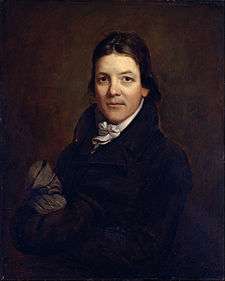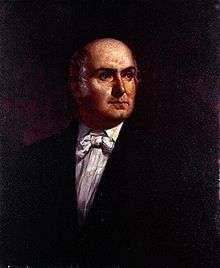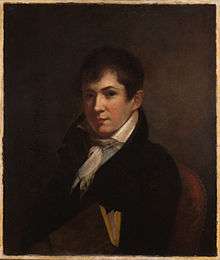Virginia Constitutional Convention of 1829–1830
The Virginia Constitutional Convention of 1829–1830 was a constitutional convention for the state of Virginia, held in Richmond from October 5, 1829 to January 15, 1830.
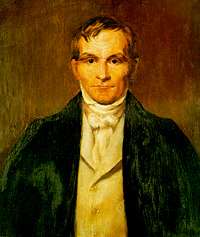
Presiding officer
Background and composition
| History of Virginia |
|---|
|
|
|
Almost immediately, the Constitution of 1776 was recognized as flawed both for its restriction of the suffrage by property requirements, and for its malapportionment favoring the smaller eastern counties. Between 1801 and 1813, petitioners called on the Assembly to initiate a constitutional convention ten times. The House of Delegates passed a bill twice, but the conservative eastern planter majority in the Virginia Senate killed both measures. Continuing growth in the western parts of the state led to another fifteen years of agitation. Several counties in the Eastern Shore, northern Piedmont and western counties began opening polls for direct expression from the voters for a constitutional convention, eventually there were twenty-eight such counties calling for reform.[1]

Malapportionment in the Assembly was seen as "an usurpation of the minority over the majority" by the slave owning eastern aristocracy. Partisans argued for apportionment by white population, versus "federal numbers" combining white population with three-fifths slaves, versus the existing system counting whites and slaves equally to favor the slave-holding eastern counties. After several General Assembly sessions with close votes for calling a convention, in 1828 the Assembly allowed for a statewide ballot for "Convention", "Neutral" or "No Convention". It passed by 56.8 percent, with most convention support coming from west of the Blue Ridge Mountains northwest to the Ohio River. But the easterners in the State Senate had stacked the deck in their favor, by apportioning the delegates by four per Senate district, producing a group of men which was more wealthy and more conservative than the House of Delegates.[2]
The last "gathering of giants"[3] from the Revolutionary generation included former presidents James Madison and James Monroe, and sitting Chief Justice John Marshall. But three generations were represented among those who would serve in public office including three presidents, seven U.S. Senators, fifteen U.S. Representatives and four governors. The other delegates to the Convention were sitting judges or members of the Virginia General Assembly.[4]
Meeting and debate
The Convention met from October 5, 1829 – January 15, 1830, and elected former president James Monroe of Loudoun its presiding officer. On December 8, Monroe withdrew due to failing health, and the Convention elected Philip Pendleton Barbour as its new presiding officer. Barbour was a former Speaker of the U.S. House of Representatives, a sitting federal district judge, and a future Justice on the Supreme Court. Conservatives among the Old Republicans such as John Randolph of Roanoke feared any change from the Founders' 1776 Constitution would lead to an ideological anarchy of "wild abstractions" imposed by egalitarian "French Jacobins" through "this maggot of innovation". In answer, John Marshall advanced his view with a petition from the freeholders of Richmond which observed that, "Virtue, intelligence, are not among the products of the soil. Attachment to [slave] property, often a sordid sentiment, is not to be confounded with the sacred flame of patriots." Any white male who had served in the War of 1812 or who would serve in the militia in there future defense of the country deserved the right to vote.[5]
|
Abel P. Upshur, a judge on the Virginia General Court, spoke for conservatives when he asserted that there "is a majority of interest as well as a majority in number". Because both persons and property were the "elements of society", majority rule by the people alone was not an equitable solution. "Those who have the greatest [property] stake in the Government…[must] have the greatest share of power in the administration of it." Lawyer John R. Cooke, a veteran of the War of 1812 countered that delegates must base the Constitution and legislative representation on the wishes of citizens, "the white population…[looking] to the people" for its authority, not only the wealthy, not to sectional slave-holding interests, and "not to the supposed rights of the [unequally populated] counties."[6]
Reformers' efforts to adopt direct popular election of the Governor were defeated in favor of continuing election by the General Assembly.[7] Thomas Jefferson Randolph, Thomas Jefferson's grandson, proposed gradual emancipation, a suggestion which never made it out of committee onto the Convention floor.[8] The reformers lost on almost every issue. Nevertheless, even with the exaggerated Virginia Senate representation apportioning the delegates in favor of the status quo, the three most important roll calls were close. The "white" population basis of apportioning the General Assembly failed by two votes. The extension of the vote to all free white males failed by two votes. When the popular election of governor passed on its first vote, it failed on reconsideration. The divisions which would lead to West Virginia's split were evident. Regardless of the various ideologies represented or delegate political affiliation, the final vote 55 for the proposed Constitution to 40 against was along an east-west divide. Only one delegate voted yes from west of the Blue Ridge Mountains.[9]
Outcomes
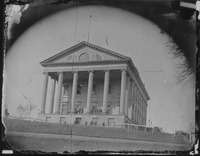
Some malapportionment in the General Assembly was eased relative to the majority of voters and white population in the Valley in the House of Delegates, but nothing for the transmontane west. Some suffrage restrictions were modified to include long term leaseholders and male heads of household.[10] The Constitution of 1830 was a "triumph of traditionalism."[11]
Historical accounts of the convention often relay interpretations of Hugh B. Grigsby that emphasize it as the “last gathering of giants.”[12] This approach typically omits names of the western reformers like Philip Doddridge who called for the convention in the first place. The "triumph of traditionalism" largely maintained traditional malapportionment preserving slaveowners’ disproportionate political power. This contributed to western Virginia counties’ later secession and formation of West Virginia led by Doddridge protégé Waitman T. Willey.
Notable attendees
- Alexander Campbell
- Philip Doddridge [13]
- James Madison
- John Marshall
- James Monroe[14]
- John Randolph of Roanoke
The delegates to the Virginia Convention of 1829-1830 – elected in May and June, 1829 at the County Courts. (Ninety-six members, four from each Senatorial District[15]
| District | Name | County |
|---|---|---|
| Amelia, Chesterfield, Cumberland, Nottoway, Powhatan and Town of Petersburg | ||
future U.S. Congressman |
John Winston Jones | Chesterfield |
future U.S. Senator |
Benjamin W. Leigh | Chesterfield |
Virginia Senator |
Samuel Taylor | Chesterfield |
Governor |
William B. Giles | Amelia |
| Brunswick, Dinwiddie, Lunenburg, and Mecklenburg | ||
militia Brigadier General |
William Henry Brodnax | Dinwiddie |
| George C. Groomgoole | Brunswick | |
past U.S. Congressman |
Mark Alexander | Mecklenburg |
future U.S. Congressman |
William O. Goode | Mechlenburg |
| City of Williamsburg, Charles City, Elizabeth City, James City, City of Richmond, Henrico, New Kent, Warwick and York |
||
U.S. Chief Justice |
John Marshall | Richmond City |
U.S. Senator, future President |
John Tyler | Charles City |
Justice, Virginia General Court |
Philip N. Nicholas | Richmond City |
Va Senator, Justice |
John B. Clopton | New Kent |
| Shenandoah and Rockingham | ||
Virginia Senator |
Peachy Harrison | Rockingham |
| Jacob Williamson | Rockingham | |
former Va Delegate |
William Anderson | Shenandoah |
| Samuel Coffman | Shenandoah | |
| Augusta, Rockbridge, Pendleton | ||
militia Major General, later Va justice |
Briscoe G. Baldwin | Augusta |
Virginia Senator |
Chapman Johnson | Augusta |
U.S. Congressman |
William McCoy | Pendleton |
future U.S. Congressman |
Samuel M. Moore | Rockbridge |
| Monroe, Greenbriar, Bath, Botetourt, Alleghany, Pocahontas, Nicholas | ||
future U.S. Congressman |
Andrew Beirne | Monroe |
former U.S. Congressman |
William Smith | Greenbrier |
Virginia Senator |
Fleming B. Miller | Botetourt |
Virginia Senator |
John Baxter | Pocahontas |
| Sussex, Surry, Southampton, Isle of Wight, Prince George, Greensville | ||
future U.S. Representative, Federal Judge |
John Y. Mason | Southampton |
U.S. Congressman |
James Trezvant | Southampton |
Virginia Delegate |
Augustine Claiborne | Greensville |
| John Urquhart | Southampton | |
| Charlotte, Halifax, and Prince Edward | ||
past U.S. Senator; U.S. Congressman |
John Randolph | Charlotte |
Virginia jurist |
William Leigh | Halifax |
Virginia Senator |
Richard Logan | Halifax |
Upper Appomattox Canal Co. |
Richard N. Venable | Prince Edward |
| Spotsylvania, Louisa, Orange, and Madison | ||
Former President |
James Madison | Orange |
presiding officer, U.S. Justice |
Philip P. Barbour | Orange |
Assembly Delegate; died without attending |
David Watson | Louisa |
Virginia Justice |
Robert Stanard | Spotsylvania |
| Loudoun and Fairfax | ||
Former President |
James Monroe | Loudoun |
U.S. Congressman |
Charles F. Mercer | Loudoun |
Virginia Senator |
William H. Fitzhugh | Fairfax |
| Richard H. Henderson | Loudoun | |
| Frederick and Jefferson | ||
| John R. Cocke | Frederick | |
Former U.S. Congressman |
Alfred H. Powell | Frederick |
resigned |
Hierome L. Opie | Jefferson |
Future U.S. Senator |
James M. Mason | Jefferson |
Assembly Delegate |
Thomas Griggs, Jr. | Jefferson |
| Hampshire, Hardy, Berkeley and Morgan | ||
Assembly Delegate |
William Naylor | Hampshire |
Virginia Senator |
William Donaldson | Hampshire |
militia Brigadier General, Virginia Senator |
Elisha Boyd | Berkeley |
U.S. Judge |
Philip Pendleton | Berkeley |
| Washington, Lee, Scott, Russell and Tazewell | ||
Assembly Delegate |
John B. George | Tazewell |
Assembly Delegate |
Andrew McMilian | Lee |
| Edward Campbell | Washington | |
Assembly Delegate |
William Byars | Washington |
| King William, King and Queen, Essex, Caroline and Hanover | ||
U.S. Congressman |
John Roane | King William |
U.S. Congressman |
William P. Taylor | Caroline |
Assembly Delegate |
Richard Morris | Hanover |
former U.S. Congressman |
James M. Garnett | Essex |
| Wythe, Montgomery, Grayson and Giles | ||
| Gordon Cloyd | Montgomery | |
Virginia Senator |
Henley Chapman | Giles |
| John P. Mathews | Wythe | |
Assembly Delegate |
William Oglesby | Grayson |
| Kanawha, Mason, Cabell, Randolph, Harrison, Lewis, Wood and Logan | ||
Virginia Senator |
Edwin S. Duncan | Harrison |
Assembly Delegate |
John Laidley | Cabell |
Assembly Delegate |
Lewis Summers | Kanawha |
Assembly Delegate |
Adam See | Randolph |
| Ohio, Tyler, Brooke, Monongalia and Preston | ||
U.S. Congressman |
Philip Doddridge | Brooke |
Virginia Senator |
Charles S. Morgan | Monongalia |
future Pres., Bethany College |
Alexander Campbell | Brooke |
| Eugenius M. Wilson | Monongalia | |
| Fauquier and Culpeper | ||
U.S. Congressman |
John S. Barbour | Culpeper |
Virginia Senator |
John Scott | Fauquier |
Assembly Delegate |
John Macrae (1829 session) |
Fauquier |
Assembly Delegate |
Thomas Marshall (1830 session) |
Fauquier |
Virginia Justice |
John W. Green | Culpeper |
| Norfolk, Princess Anne, Nansemond and Borough of Norfolk | ||
U.S. Senator; future Governor |
Littleton W. Tazewell | Norfolk Borough |
| Joseph Prentis | Nansemond | |
resigned |
Robert B. Taylor | Norfolk Borough |
Assembly Delegate |
Hugh Blair Grigsby[16] | Norfolk Borough |
U.S. Congressman |
George Loyall | Norfolk Borough |
| Campell, Buckingham and Bedford | ||
Virginia Senator |
William Campbell | Bedford |
| Samuel Claytor | Campbell | |
resigned |
Callowhill Mennis | Bedford |
Virginia Senator |
James Saunders | Campbell |
| Franklin, Patrick, Henry and Pittsylvania | ||
Virginia Senator |
George Townes | Cheserfield |
Virginia Senator |
Benjamin W. S. Cabell | Pittsylvania |
Virginia Senator |
Joseph Martin | Henry |
future U.S. Congressman |
Archibald Stuart | Patrick |
| Albemarle, Amherst, Nelson, Fluvanna and Goochland | ||
former U.S. Senator, Governor |
James Pleasants | Goochland |
U.S. Congressman |
William F. Gordon | Albemarle |
Virginia jurist |
Lucas P. Thompson | Amherst |
Assembly Delegate |
Thomas Massie, Jr. | Nelson |
| King George, Westmoreland, Lancaster, Northumberland, Richmond, Stafford and Prince William |
||
Virginia Senator; died |
William A. G. Dade | Prince William |
former Virginia Senator |
Ellyson Currie | Lancaster |
former U.S. Congressman |
John Taliaferro | King George |
| Fleming Bates | Northumberland | |
| Mattews, Middlesex, Accomack, Northampton and Gloucester | ||
Assembly Delegate |
Thomas R. Joynes | Accomack |
former U.S. Congressman |
Thomas M. Bayly | Accomack |
Assembly Delegate; died |
Calvin H. Read | Northampton |
Virginia jurist, future Sec. Navy, Sec. State |
Abel P. Upshur | Northampton |
See also
References
- Shade 1996, p. 57-61
- Shade 1996, p. 62-64
- Gutzman 2007, p. 163, 165
- Gutzman 2007, p. 163, 165
- Shade 1996, pp. 65–66
- Shade 1996, pp. 65
- Gutzman 2007, p. 188
- Andrews 1937, p. 430
- Heinemann 2007, p. 173-174
- Shade 1996, p. 64
- Heinemann 2007, p. 173
- Richards, Samuel J. (Fall 2019). "Reclaiming Congressman Philip Doddridge from Tidewater Cultural Imperialism". West Virginia History: A Journal of Regional Studies. 13 (1): 4–5.
- Richards, Samuel J. (Fall 2019). "Reclaiming Congressman Philip Doddridge from Tidewater Cultural Imperialism". West Virginia History: A Journal of Regional Studies. 13 (2): 1–26.
- Gutzman 2007, p. 163, 165
- Pulliam 1901, p. 67, 70-72
- Pulliam 1901, p. 77
Bibliography
- Andrews, Matthew Page (1937). Virginia, the Old Dominion. Doubleday, Doran & Company. ASIN B0006E942K.
- Gutzman, Kevin R.C. (2007). Virginia’s American Revolution: from Dominion to Republic, 1776-1840. Lexington Books. ISBN 978-0-7391-2131-3.
- Heinemann, Ronald L. (2008). Old Dominion, New Commonwealth: a history of Virginia, 1607-2007. University of Virginia Press. ISBN 978-0-8139-2769-5.
- Pulliam, David Loyd (1901). The Constitutional Conventions of Virginia from the foundation of the Commonwealth to the present time. John T. West, Richmond. ISBN 978-1-2879-2059-5.
- Richards, Samuel J. (Fall 2019). "Reclaiming Congressman Philip Doddridge from Tidewater Cultural Imperialism". West Virginia History: A Journal of Regional Studies. 13 (2): 1-26.
- Shade, William G. (1996). Democratizing the Old Dominion: Virginia and the Second Party System, 1824–1861. University of Virginia Press. ISBN 978-0-8139-1654-5.
External links
- Proceedings and Debates of the Virginia State Convention of 1829–30. Samuel Shepherd & Co. for Ritchie & Cook 1830 Richmond online from the archives of the University of Virginia at archive.org
